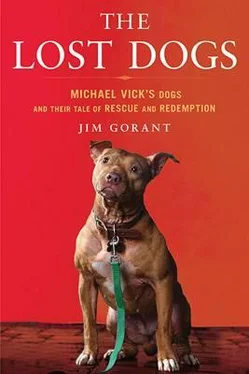Pit bulls weren’t so lucky. In the mid-1970s enterprising reporters began writing about the underground world of dogfighting, in hope of exposing and ending the practice. In the process they wrote about the tenacious and powerful dogs that were considered the ultimate fighters: pit bulls.
This had the effect of promoting pit bulls as next in the line of tough-guy dogs. By the early 1980s, the pit bull’s reputation made it popular among an emerging drug and hip hop culture. As with those before it, the breed’s popularity soared. Between 1983 and 1984 the United Kennel Club reported a 30 percent increase in registrations. And many pit bulls were not even being registered.
Between 1966 and 1975 there was one newspaper account of a fatality that resulted from a pit bull attack. In 1986, pit bulls appeared in 350 newspaper, magazine, and journal articles. Some of those reported legitimate pit bull attacks-the price of so many unsocialized, abused, and aggressively trained dogs popping up around the country-but many were the result of pit bull hysteria, in which almost any incident involving a dog was falsely reported as a pit bull attack. The breed, which had existed in some form for hundreds of years, didn’t suddenly lose control. The dogs simply fell into the hands of many more people who had no interest in control.
By 2000, pit bull fear and hype had reached such proportions that the breed was banned in more than two hundred cities and counties around the United States. Lost in all the legislation was the fact that for decades the pit bull had been considered one of the most loyal, loving, and people-friendly dogs on the planet.

Huss and Racer could not undo that tortured history, but they could impact the future of at least forty-eight pit bulls and hope to set an example that would help turn the tide for the rest. That’s why they spent two and a half days communing with the dogs, reviewing previous evaluations, and interviewing shelter attendants. But the most radical thing they did occurred at lunch on the final day. At a small pizza place Racer pulled out a piece of paper that listed each dog by its shelter I.D. number, color, and gender. Then he and Huss went down the list and gave each dog a name.
Suddenly these were no longer the Bad Newz dogs or those pit bulls from Vick’s place. They were Oscar and Rose, and Ernie and Charlie and Ray and Curly and forty-two others. They were no longer a story or a group or a commodity, they were forty-eight individual dogs in the same situation.
Despite how far they’d come, their destiny was not yet certain-any proposal still had to be approved by the court. But no one names a thing that doesn’t have hope. No one names a thing that doesn’t have a future. No one names a lost dog.
The Vick dogs had been found. Could they be saved?
THE GUY BEHIND THE rental counter made small talk-“What brings you to this part of the country?” sort of talk. Donna Reynolds and Nicole Rattay did their best to deflect the questions, and when necessary, they outright lied. They told the man they had been visiting in the area and decided they wanted to see more of the country.
They couldn’t tell the truth, couldn’t say they were renting an RV from him so that they could transfer thirteen pit bulls seized from the most highly publicized dogfight bust ever from southern Virginia to northern California. Especially since the dogs were still legally government property and the two women were operating under a strict federal gag order. That was, however, precisely the situation.
If Rebecca Huss’s first days on the job indicated that she was moving quickly, the week that followed did nothing to dispel the notion. By the time Huss and Racer were wrapping up their evaluations on Thursday, October 18, Reynolds, Rattay, and her husband, Steve Smith, were flying into town. Rattay was one of BAD RAP’s most enthusiastic volunteers and Smith was her willing partner. Among the powers granted to Huss was the ability to transfer the dogs to interim housing if she felt it was in their best interest. BAD RAP had lined up enough foster homes in California for thirteen dogs and the plan was to get them out of the shelters and into houses as quickly as possible.
So on Friday, Reynolds and Rattay rented the RV, bought thirteen portable dog pens, food, leashes, and other supplies. On Saturday, they drove around to the shelters picking up the dogs, and sometime just after dark Nicole and Steve shoved off for Oakland while Reynolds stayed behind.
Like so many others who came in contact with the dogs, Steve and Nicole didn’t know quite what to expect. They’d heard the horror stories and yet they’d also heard much more positive things from the evaluation team. Not wanting to take any chances, they secured the pens throughout the RV with bungee cords and put cardboard barriers in between so the dogs would not be able to see one another.
The trip’s start provided hope. The dogs had been so happy to get out of the shelters that they offered little resistance when it came to loading onto the RV. Some of them didn’t quite know how to do it, but with a little prodding and some gentle direction every dog got where it needed to go. They settled in quickly.
Nicole was surprised at how little they barked, and once the RV got on the highway, the gentle rocking of the cabin and the steady hum of the road put most of the dogs right to sleep. It was as if, finally removed from the stress and noise of the shelter, the dogs were taking the opportunity to simply relax.
It helped that most of the dogs on board were designated as foster-home dogs, which meant they were among those that showed the most promise. Still, that didn’t mean the ride would be easy. Steve and Nicole took turns, one driving while the other slept in the passenger seat, and continued straight through the night.
They made their first stop early the next morning. As they wiped their eyes and stretched they devised a simple plan: Each would walk one dog, letting it stretch and relieve itself, then give it some water and get it back in its pen with food. That done, they’d move on to the next two dogs. Nicole figured it would take about an hour to get all thirteen dogs done.
It took two. Two hours of walking and watering and feeding. Lifting out of the pens and placing into the pens. It was exhausting and time-consuming, but there was no choice.
The process also drew its share of funny looks. It’s one thing to climb out of an RV with a few dogs. But to keep going in and coming out with yet another set of dogs looked like a circus act and people noticed. At one park in northern Arkansas a groundskeeper kept staring at them. Nicole started to get a little annoyed-they were cleaning up after the dogs and no one was being bothered. Why couldn’t the guy chill out?
Finally, he approached. “You can’t be here with those dogs,” he said. “There’s a few places just up the road where you’re not allowed to keep ’em, and if someone complains or if they see ’em, they’ll take ’em from you. No questions asked.” Nicole was taken aback. The man was not a pit bull hater, he was a pit bull helper. She thanked him, and she and Steve quickly got the dogs back on the RV and got out of the area.
Whatever difficulties they encountered did not come from the dogs. They were great. On the second day Nicole removed the cardboard from between the cages. Taking the dogs in and out for walks had made it clear that there was no animosity between them, as they were almost always happy to see and greet one another as they passed by. With the cardboard out of their way, the dogs were even happier and some of them even licked each other’s faces through the grating of their pens.
Читать дальше













